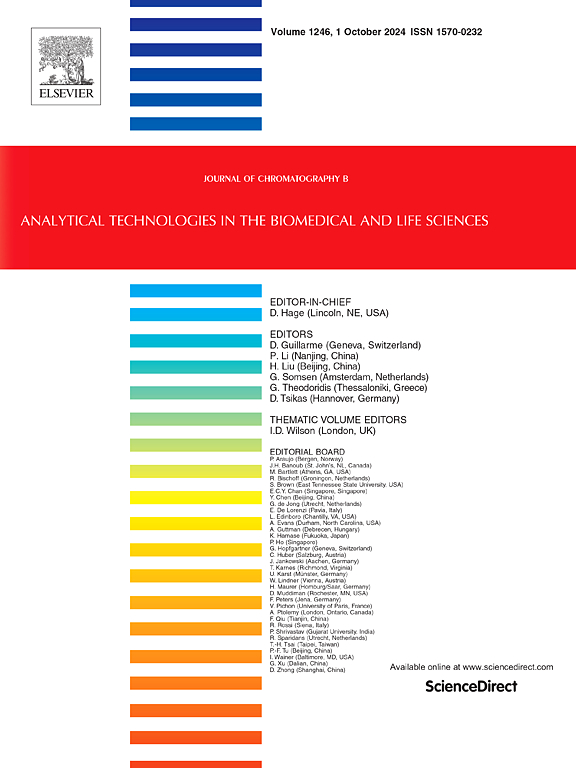A simple and efficient approach to overcome the purification bottleneck of polar unstable prodrugs & New Chemical Entities (NCEs)
IF 2.8
3区 医学
Q2 BIOCHEMICAL RESEARCH METHODS
引用次数: 0
Abstract
High-Performance Liquid Chromatography (HPLC), a sophisticated form of column chromatography, remains a workhorse technique that is commonly used in the pharmaceutical industry and academia for the purification of organic substances from complicated mixtures. The HPLC technique uses a high-pressure pump through a chromatographic column packed with small particles with a mobile phase buffer system which could be acidic, basic, or neutral and is chosen based on the compatibility requirements of the compound to be purified. However, purification of prodrugs that have highly sensitive cleavable linkers remains challenging via HPLC conditions. The sensitivity of the linkers is due to their instability to either basic or acidic conditions. Even though a neutral buffer method is developed for such compounds, the majority of compounds often degrade due to their longer contact time with the aqueous mobile phase during prep. HPLC and lyophilization. Towards this, we propose a simple method of purification of such compounds which is efficient and cost-effective. This method utilizes hydrophobic, reverse-phase, silica-bound C18 cartridges on a bench-top setup. We compared the effectiveness of purification of some sensitive compounds using these cartridges with the conventional prep-HPLC purification. Our method reduces cost, minimizes solvent consumption, and reduces purification time drastically. The compounds were obtained with a good recovery and purity using cartridges as shown in Fig. 1. This method was suitable for purifying compounds that had stability issues during prep-HPLC purification.
In addition, we hope this method being versatile and simple would promote routine purification and catalyze innovation in colleges and institutes around the globe that cannot afford preparative HPLC for routine purification. Even in industry, our learning is that this method when used in tandem with preparative HPLC as it reduces TAT (turnaround time), is cost-effective, and prolongs prep HPLC column life. Also, we demonstrated that this cartridge method can be used in tandem with prep. HPLC in industry. This reduces net purification machine time, reduces cost, and prolongs HPLC column life.

一种克服极性不稳定前药&新化学实体(NCEs)纯化瓶颈的简单高效方法
高效液相色谱法(HPLC)是柱色谱法的一种复杂形式,仍然是一种常用的技术,通常用于制药工业和学术界从复杂混合物中纯化有机物质。HPLC技术使用高压泵通过充满小颗粒的色谱柱,流动相缓冲系统可以是酸性,碱性或中性的,并根据要纯化的化合物的相容性要求选择。然而,通过高效液相色谱条件纯化具有高度敏感的可切割连接体的前药仍然具有挑战性。连接剂的敏感性是由于它们在碱性或酸性条件下都不稳定。尽管为这类化合物开发了一种中性缓冲方法,但在制备、HPLC和冻干过程中,由于大多数化合物与水流动相接触时间较长,它们往往会降解。为此,我们提出了一种简单、高效、经济的纯化方法。该方法利用疏水,反相,硅结合C18墨盒在台式设置。我们比较了使用这些墨盒纯化某些敏感化合物与传统的高效液相色谱纯化的有效性。我们的方法降低了成本,最大限度地减少了溶剂消耗,并大大缩短了净化时间。使用图1所示的墨盒获得了具有良好回收率和纯度的化合物。该方法适用于纯化前高效液相色谱中存在稳定性问题的化合物。此外,我们希望这种方法的通用性和简单性能够促进常规纯化,并催化全球无法负担制备型HPLC进行常规纯化的高校和研究机构的创新。即使在工业中,我们的经验是,这种方法与制备型HPLC串联使用,因为它减少了TAT(周转时间),具有成本效益,并延长了制备型HPLC柱的寿命。此外,我们还证明了该方法可以与制备高效液相色谱在工业上串联使用。减少净净化机时间,降低成本,延长HPLC柱寿命。
本文章由计算机程序翻译,如有差异,请以英文原文为准。
求助全文
约1分钟内获得全文
求助全文
来源期刊

Journal of Chromatography B
医学-分析化学
CiteScore
5.60
自引率
3.30%
发文量
306
审稿时长
44 days
期刊介绍:
The Journal of Chromatography B publishes papers on developments in separation science relevant to biology and biomedical research including both fundamental advances and applications. Analytical techniques which may be considered include the various facets of chromatography, electrophoresis and related methods, affinity and immunoaffinity-based methodologies, hyphenated and other multi-dimensional techniques, and microanalytical approaches. The journal also considers articles reporting developments in sample preparation, detection techniques including mass spectrometry, and data handling and analysis.
Developments related to preparative separations for the isolation and purification of components of biological systems may be published, including chromatographic and electrophoretic methods, affinity separations, field flow fractionation and other preparative approaches.
Applications to the analysis of biological systems and samples will be considered when the analytical science contains a significant element of novelty, e.g. a new approach to the separation of a compound, novel combination of analytical techniques, or significantly improved analytical performance.
 求助内容:
求助内容: 应助结果提醒方式:
应助结果提醒方式:


